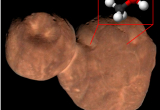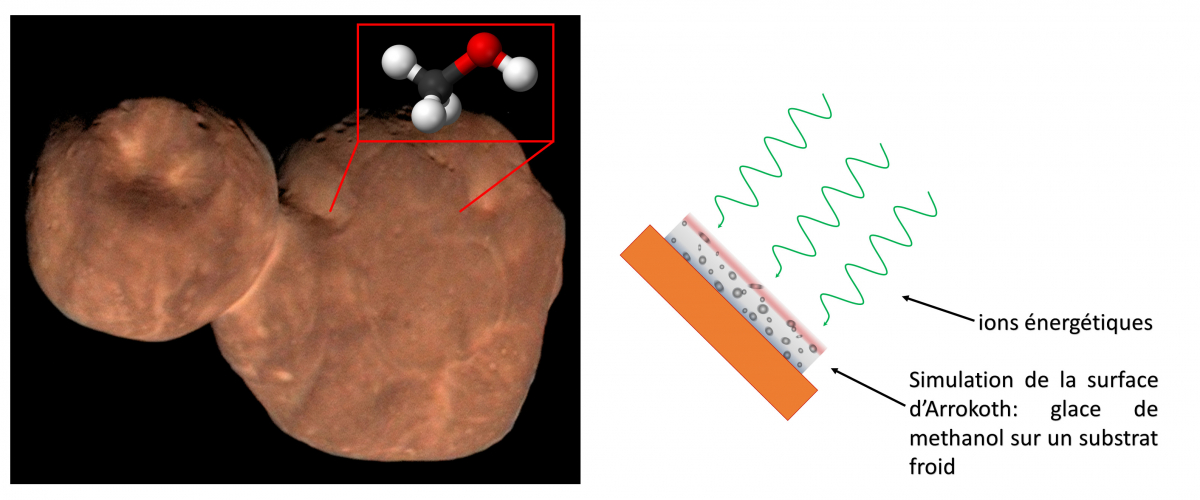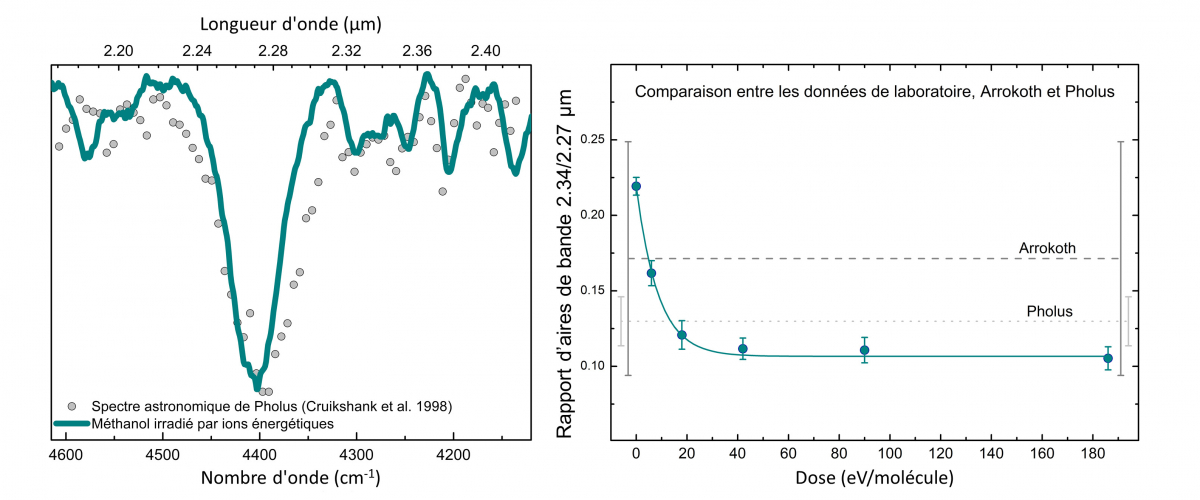How long does it take to alter the surface of a frozen asteroid?
Frozen surfaces of small bodies in the outer Solar System are exposed to cosmic and solar energetic ions. Thanks to laboratory experiments, scientists from the “Astrochemistry and Origins” team at IAS and the Florida Space Institute (USA) estimated the alterations induced by ion irradiation on the methanol-rich surfaces of such objects.
Arrokoth is a small body in the Kuiper-belt discovered in 2014 with the Hubble space telescope. Arrokoth became then the target of the New Horizons (NASA) extended mission in the Kuiper-belt, after the space probe flybys of Pluto. As a matter of fact, Arrokoth is the most distant object ever studied by a spacecraft. From an altitude of about 3500 km, the instruments on board New Horizons acquired images and spectra that displayed the presence of methanol ice. This compound was previously detected on other frozen bodies, such as the centaur 5145 Pholus and the transneptunian (55638) 2002 VE95.
These objects share another common feature: their surfaces are red! Such “reddening” can be explained by the presence of semi-refractory organic compounds mixed with ices. These organic compounds were either directly inherited from the pre-solar cloud or the protoplanetary disk, or produced at the surface of the frozen objects after their irradiation by cosmic rays and solar energetic particles (SEP).
To better understand the evolution of such surfaces, the IAS team performed experiments with the INGMAR-T set-up (IAS/CSNSM) coupled with the SIDONIE (CSNSM) ion accelerator to reproduce the irradiation conditions of Arrokoth and of other methanol-rich objects (Fig. 1). These experiments allowed finding out spectral evidences of irradiation and using them to estimate the exposition time of irradiated methanol-rich surfaces. As a result, the surface of Pholus shows evident effects of irradiation from energetic particles (Fig. 2), while on Arrokoth such effects are less pronounced.
The study also revealed that, among the different populations of energetic particles in space, SEP are primarily responsible for the alteration of frozen bodies and, as a consequence, they could be at the origin of the reddening of methanol-rich surfaces. These particles are emitted by solar active regions and flares. Since their effect diminishes with the distance from the Sun, Arrokoth, that is farther than Pholus, is less altered by SEP. This means that on Pholus, changes induced by irradiation would be evident after about 6 million years, while about 30 million years would be required on Arrokoth.
In the future, observations with the James Webb Space Telescope will provide more details on the composition of frozen outer objects. The results obtained at IAS will support the interpretation of the new observations and will help us understanding the properties of outer Solar System bodies.
Contact at IAS : Riccardo Giovanni Urso
Scientific paper : Urso, R. G., Baklouti, D., Djouadi, Z., Pinilla-Alonso, N. & Brunetto, R., 2020. Near-infrared Methanol Bands Probe Energetic Processing of Icy Outer Solar System Objects. ApJ Letters, 894, 1, L3, https://doi.org/10.3847/2041-8213/ab8ad9






